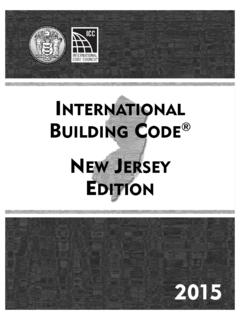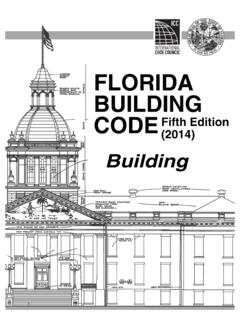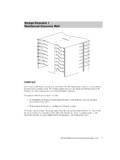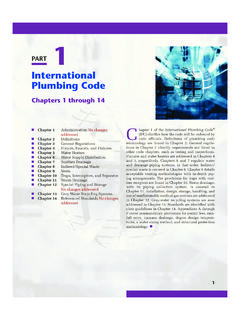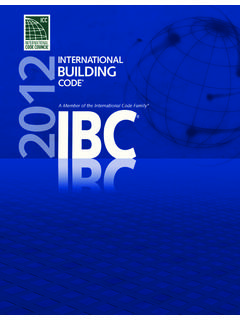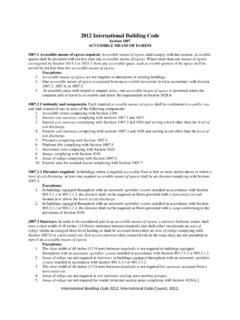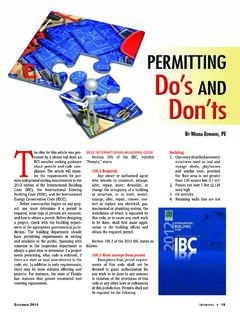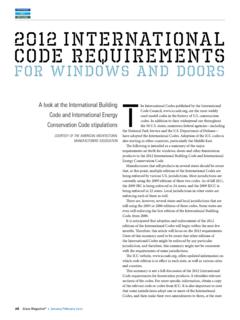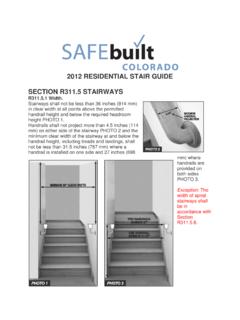Transcription of 2012 IBC Chapter 6 - iccsafe.org
1 OBJECTIVE:REFERENCE:KEY POINTS:To gain an understanding of how a building is classified as a specific type of construction,based on the construction materials and the various building elements resistance to 6, 2012 international building code What do the various types of construction indicate? How are the required fire-resistance ratings of building elements determined? Why are exterior walls regulated by additional criteria? Why are exterior walls protected differently based on fire separation distance? At what minimum distance is the protection of exterior walls unnecessary? Which types of materials are required to be used as building elements of a Type I or IIbuilding? How do the two different categories of Type I construction differ in fire protection? TypeII construction? Which types of materials are required for use in the exterior walls of a Type III structure?
2 In the interior building elements? What is another name for Type IV construction? How shall exterior walls be constructed? Interior building elements? What are the minimum construction details for columns used in a building of Type IVconstruction? In Type IV buildings, what is the minimum size of heavy-timber members used in the floorand roof framing? Floors? Roofs? Partitions? Where the minimum dimensions for Type IV solid sawn members are prescribed, how arethe equivalent sizes established for glued laminated members? Type V buildings may be constructed of which building materials? How does a Type VA building differ from a Type VB building ? In noncombustible Type I and II buildings, where may fire-retardant-treated wood beused? Which specific allowances are provided for combustible materials in Type I and Type IIbuildings?632012 IBC Chapter 6 Types of ConstructionStudy Session3 KEY POINTS:(Cont d) What are the limitations for the use of fire-retardant-treated wood in the roof constructionof noncombustible buildings?
3 In nonbearing partitions? In nonbearing exterior walls? Which building elements are considered structural frame elements for the determinationof fire resistance? Secondary members? When are bracing members considered part of the structural frame? Under which conditions may the required fire resistance of roof supports be reduced? At what height may the required fire resistance of roof construction be eliminated? Inwhich occupancies is the elimination not applicable? For which building elements are heavy-timber members and 1-hour fire-resistance-ratedconstruction interchangeable? How can a sprinkler system affect a building s type of construction classification? How are interior nonbearing walls regulated for fire resistance based on constructiontype? Exterior nonbearing walls?642012 IBC Study CompanionTopic:Construction TypesCategory:Types of ConstructionReference:IBC :Construction ClassificationStudy Session 365It is the intent of theInternational building Codethat each building be classified as a single type ofconstruction.
4 The construction materials and the degree to which such materials are protecteddetermine the classification based on the criteria of Table 601 and Chapter Text:Discussion andCommentary:Buildings and structures erected or to be erected, altered or extended in height or area shallbe classified in one of the five construction types defined in Sections through are two major groupings based on the construction materials: noncombustibleconstruction (Types I and II) and noncombustible or combustible construction (Types III, IVand V). These groupings are divided into two more categories: protected, where the majorstructural elements are provided with some degree of fire resistance, and unprotected, whereno fire protection of the building elements is typically mandated. Protected construction isfurther distinguished in Type I buildings where the required protection for many structuralelements exceeds a 1-hour fire-resistance rating.
5 ! ""Topic:Fire Resistance RatingsCategory:Types of ConstructionReference:IBC , Table 601 Subject:Construction Classification662012 IBC Study CompanionWhere a structure is separated by one or more fire walls, the code treats those individualcompartments created by the fire walls as separate buildings. Thus, each separate compartmentwould be considered a distinct building for the purpose of classification by type of Text:Discussion andCommentary:The building elements shall have a fire-resistance rating not less than that specified in Table601. The protection of openings, ducts and air transfer openings in building elements shallnot be required unless required by other provisions ofthe building elements regulated by Table 601 for types of construction include structuralframe members, such as columns, girders and trusses; bearing walls, both interior andexterior; floor construction, including supporting beams and joists; and roof construction,consisting of supporting beams, joists, rafters and other members.
6 The requiredfire-resistance rating for each of these elements is based on the specific type of constructionassigned to the building . The required fire-resistance rating can be as high as a 3-hour or aslittle as a 0-hour (no fire-resistance rating required).Topic:Fire Separation DistanceCategory:Types of ConstructionReference:IBC , Table 602 Subject:Exterior WallsStudy Session 367 The fire separation distance is defined in Section 202 as the distance measured from the buildingface to the closest interior lot line, to the centerline of a street, alley or public way, or to an assumedimaginary line between two buildings on the same Text:Discussion andCommentary:Exterior walls shall have a fire-resistance rating not less than that specified in Table rationale behind exterior wall protection is that an owner has no control over what occurson an adjacent lot. The lot line concept provides a convenient means of protecting onebuilding from another insofar as radiant heat could potentially be transmitted from onebuilding to another during a fire.
7 The requirements are based on fire separation distance, which must be considered for all exterior walls. Where such walls are also bearing walls, theprovisions of Table 601 also apply, governed by the more restrictive of the hourly provisions for exterior walls are found in Section 602 Regulates Exterior Walls Only Table 602 used in conjunction with Table 601 forfire resistance of exterior bearing walls Only Table 602 used for nonbearing exterior walls Based primarily on occupancy type Highest required rating for exterior wall is 3 hours Final threshold at 30' Additional provisions for exterior walls andopenings in Section 705

